Classification
Domain: Eukarya
Kingdom: Animalia
Phylum: Chordata
Class: Amphibia
Order: Anura
Family: Bufonidae
Genus: Atelopus
Species: zeteki
Image created by Bryan Johnson
Domain: Eukarya
The domain eukarya is unique from
the other domains (bacteria, archaebacteria) in that it contains
organisms with eukaryotic cells. All eukaryotic cells contain membrane bound
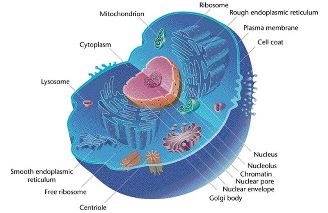 organelles, or specific bodies within the cell
that are surrounded by their own plasma membrane and carry out a
specific function for the cell. These organelles can include
the nucleus, mitochondria, chloroplasts, endoplasmic reticulum, etc.
Atelopus zeteki is comprised of eukaryotic cells just as all other
animalia are, thereby, placing it under the domain eukarya. An
example of another organism under this domain would be
Ailuropoda melanoleuca, otherwise known as the Giant Panda.
organelles, or specific bodies within the cell
that are surrounded by their own plasma membrane and carry out a
specific function for the cell. These organelles can include
the nucleus, mitochondria, chloroplasts, endoplasmic reticulum, etc.
Atelopus zeteki is comprised of eukaryotic cells just as all other
animalia are, thereby, placing it under the domain eukarya. An
example of another organism under this domain would be
Ailuropoda melanoleuca, otherwise known as the Giant Panda.
Kingdom: Animalia
The kingdom animalia is characterized by all of its members being multicellular as well as heterotrophic on the most basic level of
similarity. Multicellularity means that many cells are not
only connected but also communicating with each other in order to
form a single functioning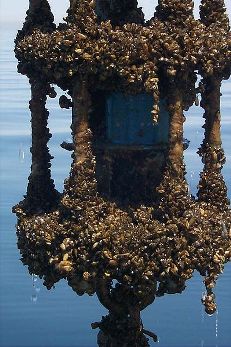 organism. Often times with multicellularity comes specialization where certain cells are
designated to carry out specific tasks. As far as all animalia
being heterotrophic, this means that the organisms are unable to
produce their own food and must consume their nutrition as indicated
by the Greek roots of the word.
organism. Often times with multicellularity comes specialization where certain cells are
designated to carry out specific tasks. As far as all animalia
being heterotrophic, this means that the organisms are unable to
produce their own food and must consume their nutrition as indicated
by the Greek roots of the word.
(hetero-) Greek for different, other
(troph-) Greek for feed, grow
In some extremely rare cases of animalia such as the Saltwater Slug, the organism is, in fact, able to participate in photosynthesis as a means of obtaining energy.
The Panamanian Golden Frog is multicellular with specialized tissues and is, indeed, heterotrophic as it is known to consume small insects and other small invertebrates in its Panamanian habitat. An example of another organism under the kingdom animalia would be Dreissena polymorpha, otherwise known as the Zebra Mussel.
Phylum: Chordata
Members of the phylum chordata are characterized by extreme
cephalization (distinct head) along with five unique characteristics
that are synonymous with the phylum:
along with five unique characteristics
that are synonymous with the phylum:
-Skeletal Rod known as a Notochord
-Dorsal nerve chord
-Pharyngeal pouches/slits
-Endostyle (Thyroid Gland)
-Postanal Tail
Now, you may be thinking that humans (chordates) do not have
postanal tails or skeletal rods! It is important to know that
these characteristics may only appear in the embryonic stages of the
organism. In the case of the Panamanian Golden Frog, the
skeletal rod is present in the embryonic stage, the pharyngeal slits
and postanal tail are present in the tadpole stage, and the
endostyle and dorsal nerve chord are present into adulthood.
Another organism that belongs to the phylum chordata would be
Castor canadensis, otherwise known as the North American
Beaver.
Class: Amphibia
The class amphibia is commonly characterized by the organisms' need
for both land and aquatic habitats. In most cases, eggs are
laid in aquatic environments and the larvae mature in the water with
the help of gills for breathing. When the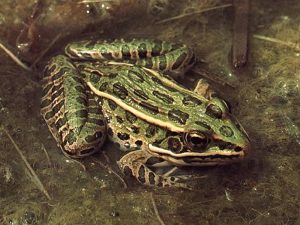 organisms become
adults, they develop lungs as well as legs to navigate land
habitats. When it is time to reproduce, the adults return to
the water and the process starts over once again. The
Panamanian Golden Frog fits into this life cycle quite well.
Eggs of the frog are laid on substrates in or near streams so the
immature tadpoles can develop in the water. They then undergo
metamorphosis and transition on to the land where they have their
adult frog morphology. An example of another organism
belonging to the class amphibia is
Rana pipiens, otherwise known as the Northern Leopard Frog.
organisms become
adults, they develop lungs as well as legs to navigate land
habitats. When it is time to reproduce, the adults return to
the water and the process starts over once again. The
Panamanian Golden Frog fits into this life cycle quite well.
Eggs of the frog are laid on substrates in or near streams so the
immature tadpoles can develop in the water. They then undergo
metamorphosis and transition on to the land where they have their
adult frog morphology. An example of another organism
belonging to the class amphibia is
Rana pipiens, otherwise known as the Northern Leopard Frog.
Order: Anura
The order anura consists of the frogs and toads.
Frogs are characterized by having long hind legs and smooth skin,
and toads are characterized by having slightly shorter forelimbs and
rougher skin. When thinking about what makes the order anura
unique, it is useful to break the word down into its Greek roots.
"An-" means not or without and "-ur-" means tail. From this,
we can conclude that organisms in the class anura do not
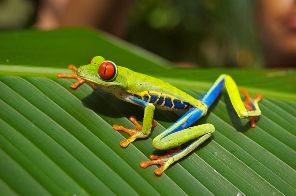 have tails
in their adult stage. In addition to no tails, they commonly
have webbed feet and large mouths in proportion to their body.
Atelopus zeteki is known as a "true toad" because of its
phylogeny but has the appearance of a frog as its common name
implies. Its long hind legs and smooth skin support it
commonly being labeled a frog. An example of another organism
fitting into the order anura would be
Aglachnis callidryas, otherwise known as the Red-Eyed Tree
Frog.
have tails
in their adult stage. In addition to no tails, they commonly
have webbed feet and large mouths in proportion to their body.
Atelopus zeteki is known as a "true toad" because of its
phylogeny but has the appearance of a frog as its common name
implies. Its long hind legs and smooth skin support it
commonly being labeled a frog. An example of another organism
fitting into the order anura would be
Aglachnis callidryas, otherwise known as the Red-Eyed Tree
Frog.
Family: Bufonidae
The family bufonidae is comprised of the "true toads".
The "true toads" have some unique characteristics that set them apart
from the other families under the order anura. All of the
bufonidae members possess Bidder's organ; an undeveloped ovary
located near the kidney that is only present in males. In
addition, they are missing teeth on their upper and lower jaws and
have a highly ossified head, meaning the skin of the head is
integrated with the skull bone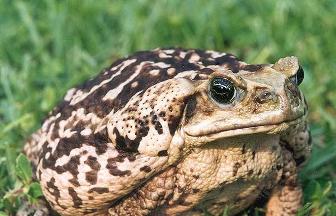 causing the head to be rather
immobile or rigid. Finally, all of the organisms under this
classification contain poison glands that secrete poisons with
varying potency depending on the species. Despite the name,
the Panamanian Golden Frog has all of these characteristics which phylogenetically place it with all of the other toads. In the
case of Atelopus zeteki, the poison secreted from its
glands is extremely toxic relative to some of its close relatives.
An example of another organism belonging to the family bufonidae
would be
Chaunus marinus, also known as the Cane Toad.
causing the head to be rather
immobile or rigid. Finally, all of the organisms under this
classification contain poison glands that secrete poisons with
varying potency depending on the species. Despite the name,
the Panamanian Golden Frog has all of these characteristics which phylogenetically place it with all of the other toads. In the
case of Atelopus zeteki, the poison secreted from its
glands is extremely toxic relative to some of its close relatives.
An example of another organism belonging to the family bufonidae
would be
Chaunus marinus, also known as the Cane Toad.
Genus: Atelopus
The genus Atelopus contains frogs that can all be found in
Central and South America. What makes this genus unique is
their relatively small size, brilliant display of bright colors on
their bodies, and their diurnal behavior - only active during the
day. Furthermore, all the frogs in this genus lack eardrums.
However, they are still able to respond to vocal calls between each
other; a rather remarkable feat. This genus of frogs also has
smaller parotoid glands compared to other toad relatives restricting
them from forming bumps on their skin. The Panamanian Golden
Frog belongs to this genus because of its small size, vibrant yellow
skin, and lack of eardrums just like its closest relatives. An
example of another organism belonging to the genus Atelopus
would be
Atelopus varius, also known as the Veragoa Stubfoot Toad.
Species: Atelopus zeteki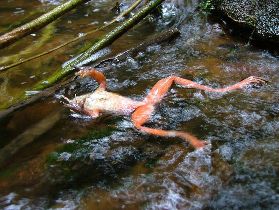
Atelopus zeteki, known as the Panamanian
Golden Frog, is unique to the tropical forests of the Central
American country Panama. This species is small in size and
exhibits a bright yellow skin with black spots; an indication of its
extreme toxicity. This toxicity comes in the form of a saxitoxin analog known as zetekitoxin
AB which can be extremely harmful and even deadly. The
Panamanian Golden Frog has a unique communication method that
consists of varying vocal calls and physical actions such as raising
its front foot. Just like
many of its closest relatives, the Panamanian Golden Frog is
struggling to survive due to the chytrid fungus. Its current
status is critically endangered.
Below are two phylogenetic trees showing the classification of Atelopus zeteki. Being that both phylogenetic trees are cladistic in nature, the classification shown takes into account evolution and shared derived characteristics of all organisms including morphological characteristics, physiological characteristics, and molecular characteristics. This type of phylogeny is preferred by scientists today because of its inclusion of molecular data. The first tree shows the Panamanian Golden Frog's general classification starting with its domain and proceeding to its family designation. The second tree is more specific and shows the frog's classification beginning with the family and proceeding to the specific species.
Image created by Bryan Johnson
Image created by Bryan Johnson
Note: Unless labeled, all images used under public permission.
To continue on to the Panamanian Golden Frog's habitat, click here.
Are you lost? Go back HOME.
